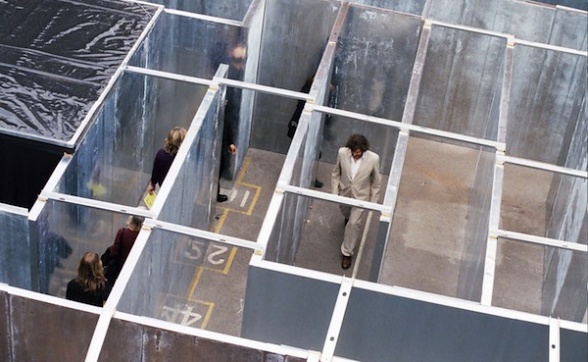Robert Wogan
Robert Wogan, Below, 2002
Two things govern Robert Wogan’s (b.1968, New York City) art practice: one is his desire to celebrate something of the former grandeur of past industrial culture and the other, the thrill that comes from exploring inaccessible, dangerous places, which, in Wogan’s case, usually means employing hazardous methods. Writing recently he said, ‘Attracted primarily to what most people consider to be obsolete relics, I have been driven by a desire to document an industrial past defined by its quest for permanence’.
For more than ten years Wogan has used forsaken industrial facilities as his arena. He has scaled tall bridges, entered abandoned buildings, and boarded the hulks of derelict ships, with little regard for his personal safety, in order to say something about the lure of industrial might. From an age that equates masculine power and empire with massive engineering feats, heavy industry embodies the signs of revolutionary change in both capitalist and communist societies in ways that still exert an influence over global society, despite their apparent redundancy in the face of digital technology.
Much of Wogan’s work has taken place on the edges of the art world, in isolated places, documented in video or photographs. He selects his sites for their sense of history or their forgotten significance. In the case of his entry into the shell of Tate Modem in 1996, for example, Wogan breached security and entered the building to make a video story about the magnificence of the old power station just before it was changed forever to become a gallery for modem art.
In his work, Wogan has extended his documentation to create installations that involve his audience in experiences that resonate with those he has undergone in his investigations. The newly commissioned piece that Wogan showed at International 02, documented his passage through the SS United States (moored in Philadelphia, Pennsylvania). The journey, shot in infrared video, was initially intended to be made in a linear fashion, with Wogan exploring the ship from the top of her stacks to the aft-most part of her shaft.
However, in shooting, Wogan found himself becoming lost and engulfed in the labyrinth of the ship’s subterranean, unlit passages. His journey became increasingly difficult as he attempted to navigate a clear path. He compared the feeling of moving through the dense space to being underwater on compressed gas. His final destination, the ship’s boiler room – a huge cavern extending over three storeys – was the highlight of the exploration. Wogan says that at this moment he ‘discovered the heart and soul of this magnificent ocean liner... the engineering of this machine seemed unfathomable to me, its size and complexity keep me awestruck’.
For International 02, Wogan’s video was projected in a steel chamber located in the centre of a labyrinth. The steel-lined maze replicated the materials and structure of the ship and the path the viewer took was frequently blocked. In order to see the final work and experience the boiler room, the viewer was subjected to similar conditions that Wogan himself experienced on board the SS United States.
Robert Wogan at Liverpool Biennial 2002
Below, 2002
Sheet steel and video projection
Commissioned by Henry Moore Foundation Contemporary Projects
Exhibited at Pleasant Street Board School
Liverpool Biennial
55 New Bird Street
Liverpool L1 0BW
- T +44 (0)151 709 7444
- info@biennial.com
Liverpool Biennial is funded by
Founding Supporter
James Moores
